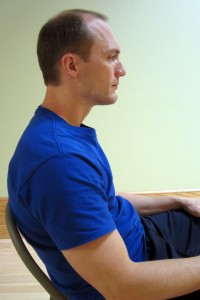Imagine how much the average person actually slouches during a day. One may slouch as she sits in a chair for breakfast, then she may hunch over the kitchen sink to wash dishes. She slouches while driving a car, then she slouches while sitting at work or at a school desk. She slouches while texting, watching TV, or using the computer. If she isn’t slouching, she’s bending over to clean or pick up children and/or pets. The list of slouching possibilities is endless!
Our bodies are designed to move both forward and backward. The problem is that we spend most of our times in a slouch, hunched over (flexed) position. Slouching is having a forward head and a rounded shoulders posture. It can also involve a posterior pelvic tilt which causes a reduction in the normal lumbar curve. This position tends to be even worse in people who are taller than average or in teenage girls and women (as many will slouch to modestly hide their chests). Over time, this constant flexed position causes excessive strain on posterior muscles, and it begins to overload the vertebral discs and ligaments which can lead to pain and injury.
Poor posture causes improper spinal positioning and affects the neck, shoulders, low back, mid back/thoracic, and ultimately, the entire body. This flexed (slouched) posture leads to postural muscle weakness which causes us to slouch more as well as predisposing us to injury. The lumbar spine is the most common area for injury (followed by the neck, mid back, and shoulders). Injuries can include: disc herniation, spinal degeneration, and shoulder impingements.
How to improve posture and eliminate pain? As simple as it sounds, first work on your posture! Sit and stand up straight. Initially, it may be difficult because the posterior chain, which includes the hamstrings, glutes, and back extensor muscles, is weak. Correcting your posture may actually cause some pain as the muscles will be utilized in a way that they aren’t used to. Persistence is crucial if you want to eliminate pain and decrease your risk of injury. The following exercises can help you to develop better posture and strength to eliminate neck, shoulder, and back pain.
- Increase Your Postural (Extensor) Muscle Strength – Refer to Prone Superman Exercises for instructions and photos of exercises that can be performed while lying on the floor or bed. The purpose of these exercises is to improve your back extensor strength, so it will be easier to maintain good posture. Move slowly and only raise the leg as far as you can without twisting.
- Perform Foam Roller (Towel Roll) Stretches – A foam roller is the best option, but you could substitute one by tightly rolling up a beach towel or by rolling a beach towel over a water noodle. Make sure to keep your knees bent and your head supported. Subscribe to my e-mail list to gain immediate access to My Top 8 Stretches to Eliminate Neck, Upper Back, and Shoulder Pain for step by step exercise instructions and photos.
- Start Squatting – The squat is a critical exercise to maintain mobility and function as we age. It is also the most beneficial exercise to develop your posterior chain. Please refer to 7 Reasons Why the Squat is Fundamental to Life.
For a comprehensive look at pain management, I recommend Robin McKenzie’s Treat Your Own Back and Treat Your Own Neck. He offers very easy and practical advice on how to treat and manage back or neck pain.
What are some different ways to raise awareness of your posture? How can you incorporate them into your daily tasks? Feel free to leave your comments below.
If you have additional questions or comments, please comment below or submit your question to contact@thePhysicalTherapyAdvisor.com. Be sure to join our growing community on Facebook by liking The Physical Therapy Advisor!


I practice yoga, and it has dramatically improved my posture over the years. More importantly, I am aware now when I am slouching!
Thank you for the great advice. We do the Superman Exercises often in my weekly class. Also, I told my husband about your recommendation of Robin McKenzie’s books.
You’re welcome! McKenzie’s books are a great place to start! Let me know if you have any specific questions or a topic that you would like me to cover in the future!